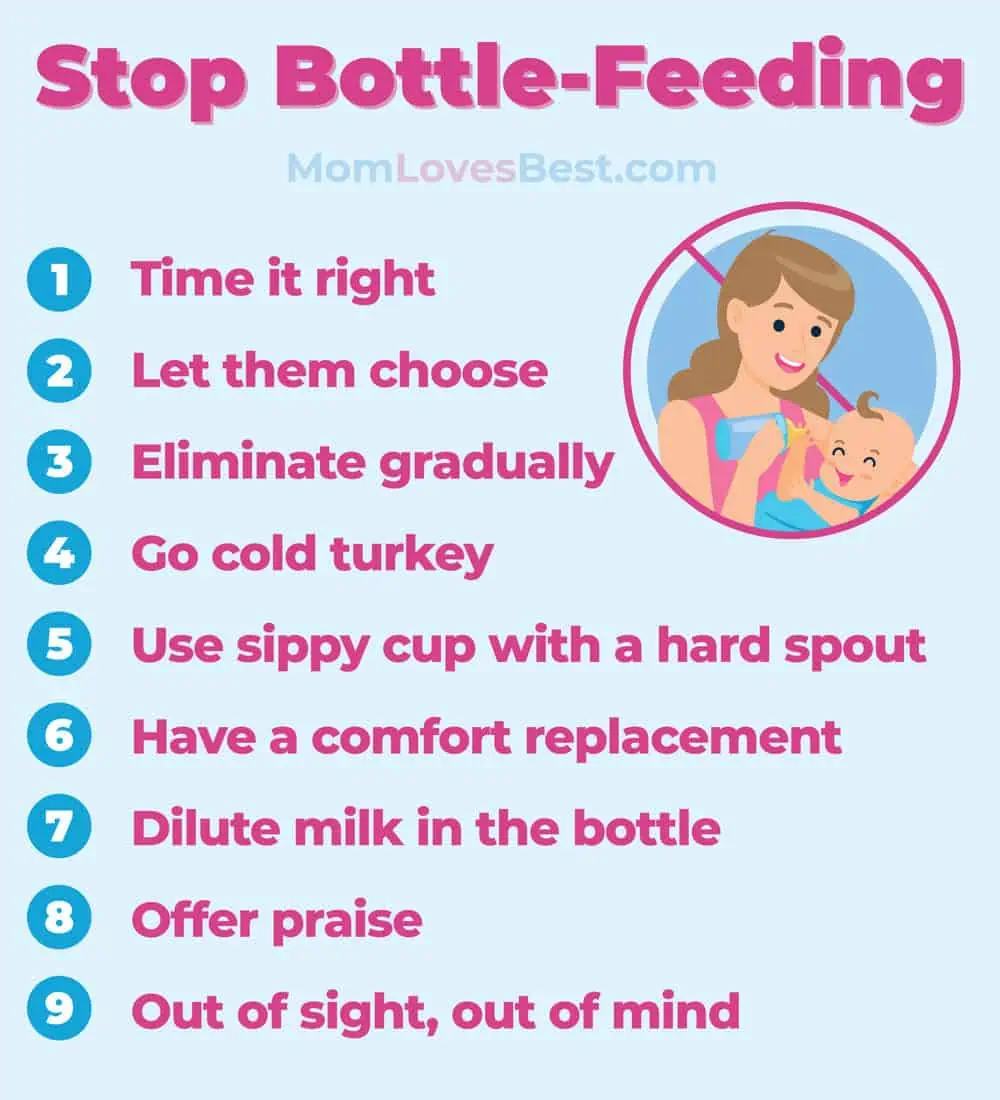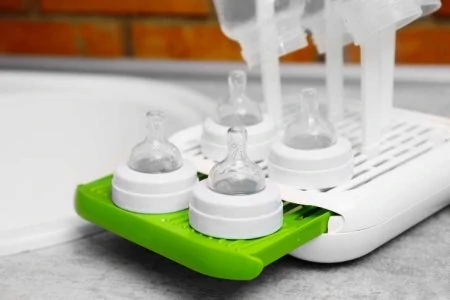So, you’re wondering if it’s time for your baby to stop bottle-feeding. It can be a tough decision to make. Babies not only take nourishment from their bottles, but they also tend to grow very attached to them.
Prolonged bottle-feeding can pose risks and make weaning difficult. But how do you know when your baby is ready to start transitioning from the bottle? And how do you make this process as stress-free as possible?
As moms, we understand that choosing to stop bottle-feeding can be an emotional step, not just for your little one but for you also. In this article, we will discuss the risks associated with prolonged bottle use, when you should start moving on from the bottle, and tips to ease the transition.
Key Takeaways
- Prolonged bottle-feeding can pose health risks for children, including tooth decay, obesity, iron deficiency anemia, and crooked teeth.
- The American Academy of Pediatrics recommends that babies start weaning from the bottle by 12 months of age and for bottles to be completely phased out by 24 months.
- It’s best to introduce a sippy cup around 6-9 months and start the weaning process by replacing one regular bottle feeding per day with a sippy when the baby is closer to a year old.
- Tips for a smooth transition include timing it right, letting the baby choose, and making the transition a special occasion.
- Gradually reducing the number of bottles over time, and providing positive reinforcement for using a cup instead of a bottle can also make the process more manageable for both the baby and the caregiver.
Reasons to Stop Bottle-Feeding
A bottle may seem harmless. It delivers nutrition to your baby, so how bad can it be? But prolonged bottle-feeding may pose health risks for children.
- Increased risk of tooth decay: Nursing on a bottle nipple throughout the day means prolonged contact with milk or juice, which can lead to cavities and tooth decay (1). Giving a bedtime bottle without brushing your baby’s teeth afterward is the biggest culprit for “bottle tooth decay.” The milk pools and will sit and “eat” at the teeth all night.
- Prolonged use linked to obesity: Babies and toddlers tend to drink more milk from a bottle than a sippy cup, and toddlers shouldn’t get more than 16-24 ounces of milk daily. Bottles can also become a comfort measure for both babies and caretakers, as it’s often instinct to offer your baby a bottle when they start crying. But milk has the same calories as food, so this calorie-dense comfort measure can quickly lead to weight gain and even obesity.
- Iron deficiency anemia: Cow’s milk can block the absorption of iron by the body. So if your child is drinking too much milk, as happens with prolonged bottle use, some of the iron they eat isn’t going to be utilized by their body to help them grow and develop (2).
- Could mess with their smile: Recent studies show that bottle-fed babies are twice as likely to have crooked teeth. The way babies suck on bottles can affect the development of their muscles, mouth, and palate, which could affect teeth and jaw alignment.
When Should Bottle-Feeding Stop?
The longer you wait to boot the bottle, the more challenging it will be for your child to let go as they become more independent and stubborn. It will also cause more stress and chaos for you.
Take Note
The American Academy of Pediatrics (AAP) recommends that babies start weaning from the bottle by 12 months of age and for bottles to be completely phased out by 24 months (3). However, the earlier you phase them out, the better.
It’s best to introduce a sippy cup around six to nine months. Start by offering your baby expressed breast milk, formula, or one to two ounces of water in a sippy cup with their meals. It may take them a few weeks to get the hang of the sippy.
When your little one is closer to a year old and has the sippy cup all figured out, start the weaning process by replacing one regular bottle feeding per day with a sippy. One year is a great time to make the switch because you’ll also be starting to switch from formula to milk.
How to Stop Bottle-Feeding
Getting rid of the bottle can be a difficult and stressful time for both you and your baby. Here are some tips to make the transition smoother and more enjoyable for everyone involved.
- Time it right: Make sure there aren’t any stressful events about to take place when starting the transition. Events like a move, the birth of a sibling, or a big family vacation could be too much for your little one. They may start to feel insecure and cling back to familiar objects or routines.
- Let them choose: Make the transition a special occasion of its own, and take your toddler to the store with you so they can pick out their own cups. You can also let them choose which cup they want to use at each feeding.
- Eliminate gradually: Introduce the sippy cup with meals around 6-9 months of age. Once they’ve mastered the sippy cup, start the transition by replacing one regular bottle feeding a day with a cup. Do that for about three days, then add on another feeding with a sippy replacement. Continue this process until all bottle-feedings have been replaced. Babies and toddlers tend to be more clingy in the morning and at bedtime, so it’s best to save those feedings for last.
- Go cold turkey: For some children, the gradual elimination simply won’t work, and you may have to try going cold turkey. All children are different, and you have to figure out what works best for your child.
- Use a sippy cup with a hard spout or straw: Dentists recommend using sippy cups with a hard spout or straw rather than ones that have soft spouts. Using a hard spout or straw won’t only benefit their teeth, but it will also make the transition less confusing. You could also go straight to an open cup like the Babycup or BabyBjorn Cup.
- Have a comfort replacement: If your child’s bottle is a comfort measure for them, try finding a security replacement such as a blanket, doll, or stuffed animal. Talk to them, and try to figure out if they are truly hungry or if something else is wrong. Offer lots of hugs, cuddles, and distractions when they are upset.
- Dilute milk in the bottle: If your little one is having a hard time letting go of the bottle, you could try diluting the milk with half water. Then gradually increase the amount of water in the bottle as the days pass until it’s just water. It’s highly likely your little one will become less interested and will start asking for the sippy cup with the yummy milk in it.
- Offer praise: Give praise and positive reinforcement to your child when they use their cup instead of the bottle. You could even give them stickers to make the sippy cup more enticing.
- Out of sight, out of mind: When you’re weaning, hide all other bottles from sight, so your little will be less apt to ask for one. When they have completely transitioned, you can either keep all the bottles hidden until your next baby is here, or you can throw a little celebration and have your toddler help you get rid of them. Explain that they are a “big kid” now, and they don’t need them anymore.
FAQs
Ditching The Bottle Without Tears
Getting your little to let go of the bottle can be difficult, but it’s essential to wean them completely by 24 months to avoid obesity, iron deficiency, tooth decay, cavities, and other dental problems.
Introduce a sippy with meals around six to nine months, and start replacing regular bottle feedings with sippy cups around their first birthday.
Help make the transition smoother for your little by timing it right, letting them pick out their cups, diluting milk in the bottle, offering praise and alternative forms of comfort, and keeping bottles out of sight.













